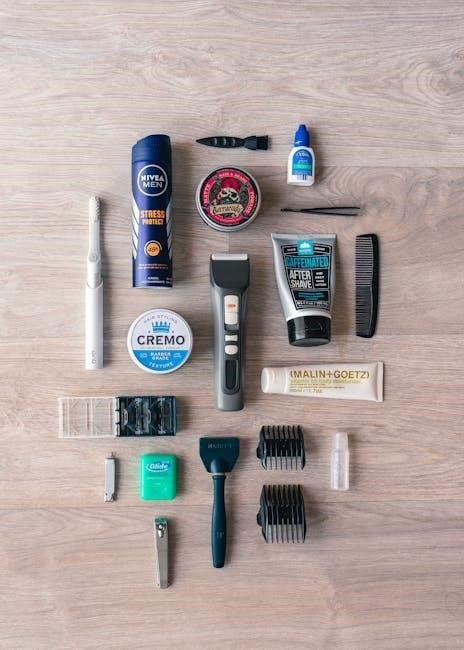Welcome to the comprehensive guide for Ryobi trimmer instructions. This manual provides essential information for safe and effective operation, including assembly, maintenance, and troubleshooting tips.
Overview of Ryobi Trimmers
Ryobi trimmers are high-quality, dependable tools designed for efficient lawn maintenance. Available in various models like A18MS01G and OLT1831, they offer advanced features such as battery-powered operation, adjustable handles, and dual-line feed systems. Engineered for ease of use and safety, these trimmers cater to both homeowners and professionals. They are built to withstand regular use while maintaining precise cutting performance. Reading the manual is crucial for understanding their features and ensuring safe operation. Ryobi trimmers are a reliable choice for trimming grass and edging lawns effectively.
Importance of Following the Instructions
Following the instructions in your Ryobi trimmer manual is crucial for safe and effective operation. Proper assembly, usage, and maintenance ensure optimal performance and prevent accidents. The manual provides detailed safety guidelines, operating procedures, and troubleshooting tips. Neglecting these instructions can lead to injuries, equipment damage, or poor cutting results. Always read and understand the manual before assembling or operating your Ryobi trimmer to maximize efficiency and safety while maintaining your lawn.

Safety Precautions
Always wear protective gear, including gloves and eyewear, when operating the trimmer. Ensure the area is clear of obstacles and bystanders to prevent accidents and injuries.
General Safety Guidelines
Always wear protective gear, including gloves, safety glasses, and long pants, to minimize injury risks. Ensure the area is clear of debris, children, and pets. Avoid loose clothing or jewelry that could get caught. Never operate the trimmer near open flames or sparks, and keep it away from water to prevent electrical hazards. Maintain a firm grip and stay balanced to prevent accidents. Be cautious of overheating and never touch the cutting head while it’s in use. Regularly inspect the trimmer for damage before operation.
Specific Warnings from the Manual
Avoid cutting near metal fences, glass, or hard surfaces, as debris may ricochet. Do not use the trimmer in wet conditions or on steep slopes. Keep children and bystanders at least 15 feet away. Never touch the cutting line with hands or objects, as it rotates at high speed. Do not modify the trimmer or use unauthorized parts, as this can void the warranty and create safety hazards. Always ensure the guard is in place to prevent accidental injuries.

Assembly and Preparation
Carefully follow the manual to unpack, inventory, and assemble your Ryobi trimmer. Attach handles securely, ensuring all connections are tightened properly. Refer to the manual for precise guidance.
Unpacking and Inventory
Begin by carefully unpacking your Ryobi trimmer and verifying all components are included. Check for the trimmer unit, handle, cutting head, and any additional hardware. Inspect for damage during shipping. Use the manual’s inventory list to ensure no parts are missing. Take note of smaller components like bolts or spacers, as they are essential for assembly. If any items are damaged or missing, contact Ryobi support immediately. This step ensures a smooth assembly process and proper functionality of your trimmer.
Handle Assembly Instructions
Assemble the handle by aligning the handle sections with the trimmer shaft. Use the provided screws to secure the handle in place. Tighten firmly, but avoid over-tightening. Ensure proper alignment to maintain balance. Adjust the handle length to your preference using the telescoping feature. Double-check all connections for stability. If unsure, refer to the manual for specific torque settings. Proper assembly ensures ergonomic use and optimal control during trimming tasks.
Attaching the Cutting Head
To attach the cutting head, first, ensure the trimmer is turned off and the battery is removed for safety. Align the cutting head with the shaft, matching the notches for proper fitting. Twist the head gently to secure it in place. Tighten any screws or clips as instructed in the manual. Ensure the attachment is firm to prevent vibration during use. Verify compatibility with your Ryobi model, especially if using a blade or string trimmer. After attachment, test the trimmer briefly to confirm smooth operation and alignment. Always follow safety guidelines to avoid accidents.

Battery and Charger Instructions
Always use genuine Ryobi batteries and chargers for optimal performance. Store batteries in a cool, dry place when not in use to maintain health and longevity.
Compatible Battery Models
The Ryobi trimmer is compatible with Ryobi 18V lithium-ion batteries, including models 1.3Ah, 2.0Ah, 4.0Ah, and 5.0Ah. These batteries are part of the Ryobi One+ system, ensuring reliable performance. Always use genuine Ryobi batteries for optimal power and runtime. Compatible chargers include the dual-chemistry charger and the fast charger. Verify compatibility before use to ensure proper function and safety. Using non-Ryobi batteries may void the warranty and compromise performance. Check the manual for a full list of approved models and chargers.
Charging Procedures
To charge your Ryobi trimmer battery, insert it into a compatible Ryobi charger. Ensure the charger is plugged into a grounded outlet. The LED light will indicate charging status: red for charging, green for fully charged. Avoid overcharging by removing the battery once fully charged. Do not leave the battery charging unattended or overnight. Let the battery cool before charging if it’s hot. Always refer to the manual for specific charging times and guidelines to maintain battery health and performance. Proper charging ensures optimal tool operation and longevity.
Battery Protection Features
Ryobi trimmer batteries include built-in protection features to prevent overcharging, overheating, and deep discharging. The battery management system monitors cell voltage and temperature to ensure safe operation. Overcharge protection extends battery life by preventing excessive charge cycles. Thermal management shuts down the battery if it overheats, safeguarding both the tool and user. These features enhance durability and reliability, ensuring your Ryobi trimmer performs optimally over time. Always use genuine Ryobi batteries to maintain these protective functions and overall tool performance.
Operating the Trimmer
Start by fueling or charging according to instructions. Ensure the cutting head is secure. Hold firmly, squeeze the trigger gently, and move steadily for even cuts. Always maintain control and keep the trimmer at a safe distance from people and pets. Adjust settings as needed for optimal performance and efficiency.
Starting the Trimmer
To start the Ryobi trimmer, ensure the safety switch is disengaged and the cutting head is free from obstructions. For gas-powered models, prime the bulb and pull the starter cord firmly. For electric or battery-powered trimmers, press the power button or pull the trigger. Always hold the trimmer upright and away from your body. Begin with a low-speed setting to maintain control. If issues arise, consult the manual for troubleshooting tips to ensure proper operation and safety.
Basic Trimming Techniques
Hold the trimmer at a slight angle, maintaining a steady grip. For even cutting, move the trimmer in a steady, sweeping motion from left to right. Keep the cutting head parallel to the ground for consistent results. Use the edge of the cutting line to avoid damaging plants. For taller growth, work in sections, starting from the base and moving upward. Regularly inspect the area to ensure an even trim. Always maintain control and avoid over-reach to prevent accidents while operating the trimmer.
Converting to Edger Mode
To convert your Ryobi trimmer to edger mode, start by turning off the device and ensuring it is safe to handle. Locate the rotating head feature, designed for edging. Rotate the cutting head 90 degrees to align it vertically with the ground. This adjustment allows for precise edge work along sidewalks, driveways, and garden beds. Use the edging guide or wheel for straight, clean cuts. This feature provides versatility, making your trimmer a multi-functional tool for both trimming and edging tasks effortlessly.
Operating Tips for Efficiency
For optimal performance, maintain a consistent cutting angle and keep the trimmer head parallel to the ground. Use a steady, sweeping motion to cover larger areas efficiently. Avoid over-revving the engine, as this can reduce runtime and increase wear. Keep the cutting line at the recommended length to ensure clean cuts and minimize waste. Regularly inspect and clean the trimmer head to prevent debris buildup. Always walk at a moderate pace to maintain control and achieve even results.

Maintenance and Care
Regularly inspect and clean the trimmer to ensure optimal performance. Lubricate moving parts and check for worn components. Store in a dry, cool place.
Regular Maintenance Checks
Perform regular inspections of the Ryobi trimmer to ensure optimal performance. Check the air filter for cleanliness and replace if necessary. Inspect the cutting line or blade for wear and damage, replacing as needed. Lubricate moving parts, such as the gearbox and shaft, to prevent friction. Tighten all bolts and screws to ensure stability. Clean the trimmer head and surrounding areas to remove debris. Check for any signs of wear on the handle or harness and address immediately. Regular maintenance extends the lifespan and efficiency of your trimmer.
Cleaning the Trimmer
Regularly clean your Ryobi trimmer to maintain performance and longevity. Use a soft brush or cloth to remove dirt and debris from the cutting head, handle, and exterior components. For tougher buildup, mix mild soap with water, apply with a soft sponge, and rinse thoroughly. Avoid using harsh chemicals or high-pressure washes, as they may damage components. Dry the trimmer with a clean towel after cleaning to prevent rust. Cleaning ensures smooth operation and prevents clogs in the cutting head or air filter.
Sharpening or Replacing the Blade
To maintain your Ryobi trimmer’s performance, sharpen or replace the blade as needed. For sharpening, use a file or sharpening stone, following the blade’s original angle. Avoid altering its shape or balance. Practice on an old blade if unsure. If the blade is too worn, replace it with a genuine Ryobi part. Ensure the trimmer is off and the battery is removed before starting. Always wear protective gloves and eyewear. Refer to the manual or online resources for detailed instructions and safety tips.
Air Filter Cleaning
Regularly cleaning the air filter ensures optimal performance and extends the life of your Ryobi trimmer. Turn off the device and remove the battery for safety. Locate the air filter, usually found near the engine. Gently brush off dirt with a soft-bristled brush or wash it with mild soap and water. Allow the filter to dry completely before reinstalling. A clean filter improves airflow, reducing strain on the motor and ensuring efficient operation. Refer to your manual for specific guidance on your model.
Winter Storage Tips
Proper winter storage ensures your Ryobi trimmer remains in excellent condition. Clean the device thoroughly, removing dirt and debris from the cutting head and handle. Drain fuel to prevent spoilage or clogging. Store the trimmer in a dry, cool place. Remove and charge the battery, storing it separately. Cover the trimmer to protect it from dust. Lubricate moving parts if necessary. Regular winter maintenance ensures your trimmer is ready for the next season. Always follow manufacturer guidelines for storage.

Troubleshooting Common Issues
Identify and resolve issues promptly to maintain performance. Common problems include startup failures and uneven cutting. Refer to the manual for diagnostic guides and solutions.
Trimmer Not Starting
If your Ryobi trimmer won’t start, check the battery charge level or fuel supply for gas models. Ensure the safety switch is engaged and the choke is properly adjusted. Verify that the spark plug is clean and functioning. For electric trimmers, confirm the power cord is securely connected. If issues persist, consult the manual or contact Ryobi support for assistance. Regular maintenance, such as cleaning the air filter, can prevent startup problems. Always follow safety guidelines during troubleshooting.
Uneven Cutting Performance
Uneven cutting performance with your Ryobi trimmer can result from a dull or damaged blade, incorrect string size, or improper technique. Ensure the cutting head is aligned and the blade is sharpened or replaced if necessary. Check the string thickness matches the recommended specification. Adjust your trimming angle and maintain consistent speed for even results. Regularly inspect and clean the cutting head to prevent debris buildup. Proper maintenance and technique adjustments can restore optimal performance.
Excessive Vibration
Excessive vibration in your Ryobi trimmer may stem from an imbalanced cutting head, loose components, or worn-out parts. Ensure all screws and bolts are securely tightened. Check the blade for damage or misalignment and replace it if necessary. Using the incorrect string size or type can also cause imbalance. Regularly inspect and maintain the trimmer’s moving parts, and consider balancing the cutting head according to the manual. Addressing these issues will help minimize vibration and improve overall performance.

Advanced Features
Ryobi trimmers offer advanced features like variable speed control, dual-line feed systems, and adjustable handle lengths for enhanced versatility and user comfort during operation.
Variable Speed Control
Ryobi trimmers feature a variable speed control, allowing users to adjust power based on the task. This ensures efficient cutting for light or heavy-duty jobs. By optimizing speed, users can extend battery life and reduce wear. The control is typically located on the handle, making it easy to adjust while operating. This feature enhances precision for delicate areas and provides more power for thicker vegetation. Adjusting speed is straightforward, with a toggle or switch that ensures seamless transitions between settings.
Dual-Line Feed System
The dual-line feed system on Ryobi trimmers enhances cutting efficiency by using two lines simultaneously, ensuring cleaner cuts and faster results. This feature is particularly effective for thicker vegetation and larger areas. The system automatically feeds the line when needed, minimizing interruptions. Users can adjust the line length for optimal performance. Proper maintenance, like regular line replacement, ensures the system works effectively. This dual-line design reduces the need for frequent line adjustments, making trimming tasks more convenient and time-efficient.
Adjustable Handle Length
The adjustable handle length feature on Ryobi trimmers allows users to customize the tool to their height and comfort. This ergonomic design reduces fatigue during extended use. To adjust, simply release the locking mechanism, slide the handle to the desired length, and secure it firmly. Proper adjustment ensures better control and balance, making trimming more efficient. This feature is especially beneficial for users of varying heights, promoting comfortable and safe operation. Always ensure the handle is securely locked before use for stability.

Storage and Transportation
Store the Ryobi trimmer in a dry, cool place, away from direct sunlight. Use the original packaging or a protective cover for transportation to prevent damage.
Proper Storage Conditions
Store your Ryobi trimmer in a dry, cool place to prevent rust and moisture damage. Avoid direct sunlight and extreme temperatures. For gas models, drain the fuel before storage. Clean the trimmer thoroughly, removing debris from the cutting head and handle. Store batteries separately in a cool, dry location. Use a protective cover to shield from dust. Keep the trimmer upright or hang it to save space. Proper storage ensures longevity and maintains performance for future use.
Transporting the Trimmer Safely
To transport your Ryobi trimmer safely, secure it in a stable position to prevent movement during transit. Use a sturdy strap or tie-down to keep it in place. Protect the cutting head with a cover or guard to avoid damage. For battery-powered models, remove or secure the battery to prevent accidental start-ups. Always use a suitable vehicle or cart for transportation. Avoid exposing the trimmer to excessive vibration or shocks. Ensure the trimmer is clean and dry before transporting to prevent damage or corrosion.

Environmental Considerations
Ryobi trimmers are designed with eco-friendly features, including energy-efficient motors and recyclable materials. Proper disposal of batteries and components is encouraged to minimize environmental impact.
Eco-Friendly Features
Ryobi trimmers incorporate energy-efficient technologies, such as lithium-ion batteries, reducing energy consumption and extending battery life. Adjustable power settings conserve energy, while lightweight materials minimize environmental impact. Many models are emission-free, offering a greener alternative to gas-powered tools. These features align with eco-conscious practices, making Ryobi trimmers a sustainable choice for yard maintenance.
Disposal Guidelines
Proper disposal of Ryobi trimmers and their components is essential for environmental protection. Battery-powered models require careful handling of lithium-ion batteries, which should not be disposed of in regular trash. Check local regulations for designated recycling centers. Metal and plastic parts can often be recycled. Do not crush or puncture batteries, as this can cause hazards. For gas-powered trimmers, drain fuel and oil responsibly. Always consult Ryobi’s official guidelines or local waste management for detailed instructions.

Warranty and Support
Your Ryobi trimmer is backed by a comprehensive warranty covering defects in materials and workmanship. For assistance, contact Ryobi customer support or visit their official website.
Understanding Your Warranty
Your Ryobi trimmer is covered by a limited warranty that typically lasts for a specified period, such as 5 years, depending on the model and usage conditions. This warranty covers defects in materials and workmanship, ensuring repairs or replacements at no cost during the warranty period. Proper registration and maintenance are often required to validate the warranty. Exclusions may apply for damage caused by misuse, accidents, or failure to follow instructions. Always review the warranty terms provided with your purchase for detailed coverage and conditions.
Contacting Ryobi Support
For assistance with your Ryobi trimmer, contact Ryobi customer support through their official website or phone. Visit the support page to find contact details, FAQs, and troubleshooting guides. Live chat is often available for immediate help. Ensure you have your model number ready for efficient service. Support teams are typically available Monday through Friday during business hours. Ryobi also offers online resources, including manuals and repair guides, to help resolve common issues quickly and effectively.
Final Tips for Effective Use
For optimal results, maintain a steady pace while trimming to avoid overheating. Keep the cutting blade sharp for cleaner cuts and better performance. Always use the correct angle for edging and trimming to achieve professional-looking results. Store the trimmer properly after cleaning to prevent damage. Explore advanced features like variable speed for tailored use. Remember, consistent maintenance and adherence to guidelines ensure longevity. Take pride in your work and stay safe!
Encouragement for Safe Operation
Always prioritize safety when using your Ryobi trimmer. Wear protective gear, including gloves and eyewear, to minimize risks. Keep children and pets away while operating. Stay alert to your surroundings and avoid trimming near open flames or sparks. Follow the manual’s guidelines to prevent accidents. Regular maintenance ensures smooth, safe operation. By being mindful and responsible, you protect yourself, others, and your equipment. Safe practices lead to better results and peace of mind.
